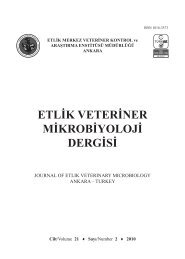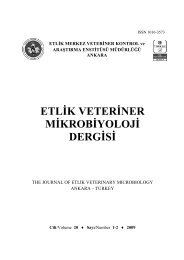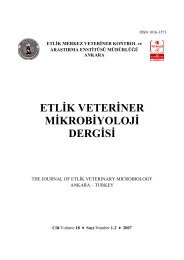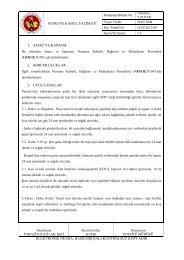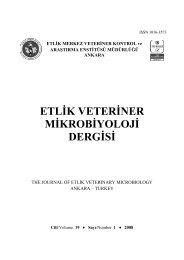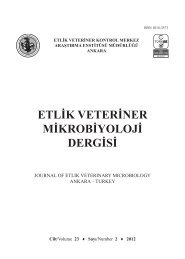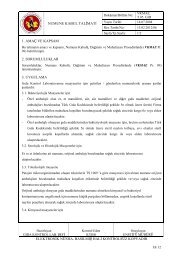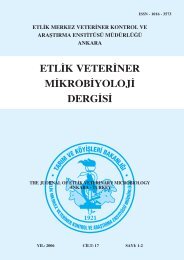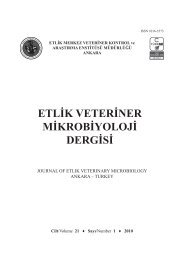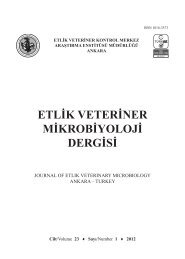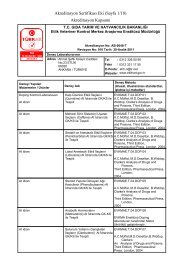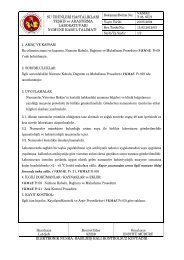etlik veteriner mikrobiyoloji dergisi - veteriner kontrol merkez ...
etlik veteriner mikrobiyoloji dergisi - veteriner kontrol merkez ...
etlik veteriner mikrobiyoloji dergisi - veteriner kontrol merkez ...
You also want an ePaper? Increase the reach of your titles
YUMPU automatically turns print PDFs into web optimized ePapers that Google loves.
Sırıken B ve ark. Etlik Vet Mikrobiyol Derg, 22, 54-60, 2011 55<br />
ment difficulties and the potential for this plasmidmediated<br />
resistance trait to be transferred to other<br />
microorganisms. Of the 24 enterococcal species<br />
identified up to now, especially E.faecalis (85-90%<br />
of isolates) and E.faecium (5-10% of isolates) are<br />
the most important ones for nosocomial infections<br />
in humans (15) and the most prevalent species in<br />
foods (6, 14, 17).<br />
Due to the heavy use of growth-promoting<br />
drugs in food animals, the antibiotic resistance<br />
in enterococci of animal origin has increased and<br />
also resistant enterococci have spread in the human<br />
population (5). This resistance can be both intrinsic<br />
that present in almost all the strains of enterococci<br />
or acquired. Cross resistances exist in related<br />
antibiotics therapeutically used in human or animal<br />
medicine such as avoparcin (similar to vancomycin,<br />
teicoplanin), virginiamycin (similar to quinupristin/<br />
dalfopristin), spiramycin, tylocin (similar to erythromycin)<br />
and avilamycin (similar to evernimisin)<br />
(23). Vancomycin, a glycopeptide antimicrobial<br />
agent has been used to treat Gram positive infections<br />
in humans. Up to date six glycopeptide resistance<br />
phenotypes; VanA, VanB, VanC, VanD, VanE<br />
and VanG, have been described in enterococci. It<br />
has been reported that they could be distinguished<br />
on the basis of the level, inducibility, and transferability<br />
of resistance to vancomycin and teicoplanin<br />
as well as associated resistance genes such as vanA,<br />
vanB, vanC, vanD, vanE, and vanG (23). Generally,<br />
the vancomycin resistance is related to inhibition of<br />
cell wall synthesis by binding to peptidoglycan precursor<br />
and inhibition of following transglycosilation<br />
modified traget of glycopeptid. The vanA genotype<br />
is the clinically most important one and widespread<br />
in enterococci. VanA resistance has been characterized<br />
as high-level, inducible and transferable. The<br />
second important genotype is vanB (23). The vanB<br />
resistance is inducible low-level vancomycin resistance.<br />
VanA resistance is usually plasmid borne<br />
but is now known to be encoded on a transposon<br />
(Tn1546) that may pass to the chromosome. VanB<br />
resistance is usually chromosomal and is occasionally<br />
transferable from chromosome to chromosome<br />
on a transposon (29). Both VanA and VanB resistance<br />
are seen most commonly in E.faecium and<br />
E.faecalis. VanD, VanE, and VanG have been reported<br />
to detect in single isolates of E.faecium and<br />
E.faecalis, respectively, until now. A constitutive<br />
low-level vancomycin resistance type, vanC geno-<br />
type has been seen in some E.gallinarum strains<br />
(26). In the late 1980s, vancomycin-resistant enterococci<br />
(VRE) were first detected in humans as specific<br />
pathogens (35). Later, molecular evidences have<br />
indicated that in Europe and other countries around<br />
the world, food-producing animals are the likely<br />
reservoir of one type of VRE, namely Enterococcus<br />
faecium strains with the vanA antibiotic-resistance<br />
gene (25, 27, 38). This case could be associated<br />
with the use of the vancomycin-related glycopeptide<br />
(vancomycin and teicoplanin), avoparcin (an<br />
analogue of the glycopeptides) as prophylactic or<br />
growth promoter in animal production (2, 38). The<br />
ability of VRE to transmit to humans via the food<br />
chain have led to the decision of banning avoparcin<br />
in the European Union since 1997 (38) and Turkey<br />
since 1999 (1). Decreases in the prevalence of VRE<br />
in animals, meat products and humans have been<br />
observed after a relatively short period of time from<br />
the banning of avoparcin use in several European<br />
countries (10, 22).<br />
Slime factor variously termed as biofilm, capsule<br />
or glycocalyx is an extracellular polymeric substance<br />
(EPS) produced by the some microorganism<br />
and play an important role in the attachment and<br />
colonization of organ or food-contact surfaces (24).<br />
The EPS also supports cell to cell bacterial contacts<br />
by means of a multilayered biofilm. Essentially, biofilm<br />
formation is a dynamic process and different<br />
mechanisms are involved in their attachment and<br />
growth. Bacteria in biofilms are generally more resistant<br />
to environmental stresses than their free-living<br />
bacteria. Therefore, EPS appear to be significant<br />
virulence factors for some bacteria such as enterococci.<br />
Like other Gram-positive microorganisms,<br />
enterococci are able to produce biofilms on abiotic<br />
surfaces and increasing their high innate resistance<br />
to antibiotics. The initial step in the colonization of<br />
surface and biofilm formation is bacterial adherence<br />
to the biomaterial. It has been reported that biofilm<br />
formation ability of enterococci is highly and significantly<br />
associated with the presence of esp gene<br />
(32).<br />
The widespread and indiscriminate use of antibiotics<br />
in human and veterinary medicine and in<br />
livestock breeding has lead to a spread of antibiotic<br />
resistance (AR) among both pathogenic and commensal<br />
microorganisms. The same AR genes have<br />
been also isolated from human and food strains.<br />
Therefore, antimicrobial resistance constitutes



